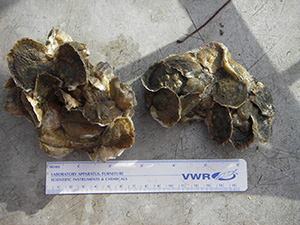3.2 Age Structure
3.3 Link to Spawning Stock Recruit Ratio
It is desirable to describe populations by age structure in that this provides running quantitative indices of both recruitment and mortality. Unlike the vast majority of bivalves oysters do not have typical symmetry in their growth form, indeed the aggregated growth in reefs generally ensures a variety of final growth shapes. Signature growth increments in the shell matrix, as seen in sections of the shell and/or hinge, are also variable and require care in interpretation. The approach employed herein uses predominantly demographic analysis bolstered by very large n values. It is, notably, in agreement with blind testing using both growth signature and isotope analysis (for discussion see Harding et al., 2008, 2010b).
 As a historical note, demographic plots prepared for each year in the 1998-2006 period for each reef surveyed in the James River for both live oysters and boxes using 5 mm bins provided limited guidance on age versus length relationships. Distinct year classes of live oysters that could be followed for a minimum of three years were rare in these plots. The period of recruitment to the benthos (also commonly termed
As a historical note, demographic plots prepared for each year in the 1998-2006 period for each reef surveyed in the James River for both live oysters and boxes using 5 mm bins provided limited guidance on age versus length relationships. Distinct year classes of live oysters that could be followed for a minimum of three years were rare in these plots. The period of recruitment to the benthos (also commonly termed
y = 30.22 + 21.6x; R2 = 0.93, n> 22,000
Using a July 1 birth date and noting that current data is for a fall survey then lengths on November 1 represent ages of 0.33, 1.33, and so on with annual increments, although for clarity throughout this text these are referred to as age classes 0 (= YOY = spat), 1, 2, 3 and >3 year olds. Corresponding lengths are 37.3 mm at 0 y, 58.9 mm at 1 y, 80.5 mm at 2 y, 102.1 mm at 3 y and 123.7 mm at 4 y. This age at length model was used to recast the length demographic as an age demographic and to estimate age-specific mortality. Mann et al. (2009b) argue that a linear age versus length fit is appropriate for early years given the life expectancy of an oyster (10-15 years in undisturbed populations, Powell and Cummings 1985), the previously mentioned plastic form and the lack of adherence to isodiametric form with allometric b values generally nearer 2 than 3 (including those presented above). James River oysters are also distinctively long and thin rather than typically cupped in shape – they have been locally described as “pencils”. Such a form approximates to a tube rather than a sphere, again allowing for a linear fit. The adoption of an age-at-length plot using the von Bertalanffy (1938) model is not considered appropriate for these oysters. In addition to the linear (best fit) model for James River
For the Great Wicomico River: included years are 2003-2009. Values of a, b and
For the Piankatank River: included years are 2003-2009. Values of a, b and
The age at length estimates for the Great Wicomico and Piankatank Rivers are slightly lower than those for the James River linear fit. Caution is required when extrapolating these fits in that the very nature of linear and quadratic fits

